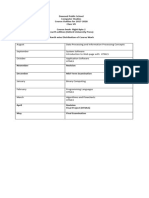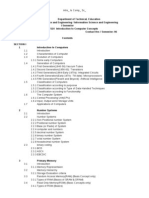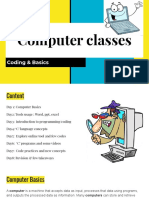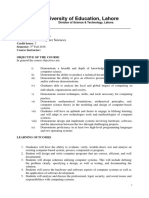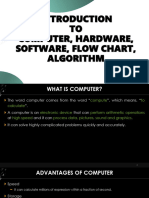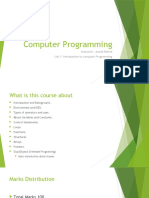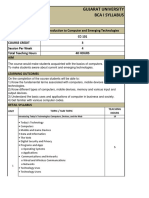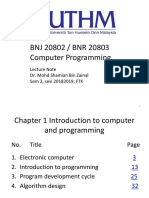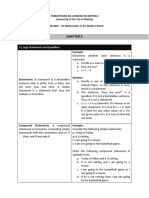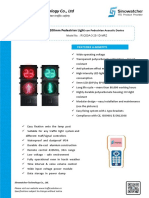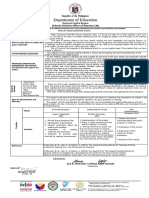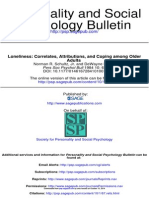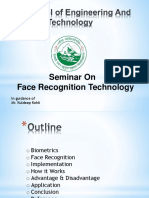My Computing Portfolio
Name: Andrew Mills
Year: 9
Data
Hardware and Communication
Information
Representation Processing AO4 and Networks Technology AO6
AO3
AO5
1. Beginner Bit AO1.1: Explain
AO2.1: Program a AO3.1: Give
AO4.1: Identify
AO5.1: Use a
AO6.1: Create and
I share my use of what is meant by device to carry out examples of
hardware and
browser to obtain use files and
technology, review an Algorithm and a simple task or
different types of software in a
info from www.
folders with
and improve my create simple
move as I require. (digital) data and computer system And explain safe suitable names.
work
flowchart
Can explain how
Correct mistakes in explain how they and explain their online
independently, algorithms with
functions and
communication
technology is used
my programing to communicate
acting upon
precise
information
relationship
and actions when at school, home
produce precise
feedback from instructions.
concerned about and in business
instructions
others
contacts
2. Novice Byte AO1.2: Explain the AO2.2: Use
AO3.2: Recognise AO4.2: Identify
AO5.2: Navigate
AO6.2:
I plan and discuss use of algorithms arithmetic
different types of different devices the web to find
Independently use
solutions, identify by digital devices operators, if
data and explain that are
and save digital
technology to
errors in programs
statements and
how they are used computers.
content.
organise content.
and debug them,
loops in a program in a program
Explain the
Demonstrate safe Evaluate quality of
explaining errors Create algorithms Use logic to
use of computers digital content,
Use tables to make difference
and solutions
between
input
and
and how to report adapt and present
that use loops and predict the
data easier to use
output with
unacceptable
using appropriate
logic
behaviour of a
examples of
content or contact software
program
devices used .
3. Apprentice - AO1.3: Use
AO2.3: Create
AO3.3: Explain the AO4.3: Explain
AO5.3: Understand AO6.3: Collect,
Kilobyte
diagrams with
programs that use difference
how different
and explain the
organise, combine
repetition and two algorithms to
between data and devices and
difference
and present digital
way selection i.e. produce solutions. information
application collect between the
content for a given
IF, THEN, ELSE to Declare and assign
data
Internet and WWW goal, to a target
express algorithms variables.
audience using
different
Explain tasks best Use post tested
Sort and search
Explain the role of Explain / use
loops e.g. until
application
completed by
information in a
hardware,
online services
and if, then and
software.
humans or
flat file
application and
such as VOIP
else statements
Demonstrate
computers
systems software
awareness of
audience and
purpose in design.
4. Specialist - AO1.4: Create
AO2.4: Explain
AO3.4: Create
AO4.4: Explain
AO5.4: Explain
AO6.4: Identify,
Megabyte
algorithms using how programs
searches using
function and range how search
explain and
subroutines with bridge gaps
boolean and
of operating
engines operate, discuss the impact
different solutions between
relational
system software
select and rank
of technology on
to problem or
algorithms and
operators
results
society
system.
computers.
Explain iteration
Use high level
Analyse the
Explain differences Create static web Design test plans
and types of
language to
reliability of data between physical, pages using HTML to evaluate
Assessment
Objectives (AO)
Algorithms
AO1
Programming
AO2
2016 2017 Computing
Projects
Autumn Term
Baseline tests Practical
and Theory
E Safety How to be safe
online
Creating Online Portfolios
Understanding Computer
Systems and Algorithms
Using Data and Data
Types
Coding with Visual
Programming Languages
Spring Term
The Online World
Understanding the
Internet and WWW
Ubiquitous Computing
and The Internet of
Things
Computers and The
Law
Understanding and
Using Databases
How to be safe online
E-SAFETY
COMPUTING PROJECT #1
Lesson 1. What are computer systems?
Genius question: What the
Objectives: 1. Describe a computer systemssimilarities between the design
of a life
computer systems and the
2. Identify and explain computers in everyday
human body?
3. Describe how computers work
What are computers?
A computer system
is
What three stages do all
computers follow
Explain with examples
from your home
1. I
2. P
3. O
Explain your examples
are computers
. How is this similar to a
human?
What does Input and Output
mean
How do computers
get data?
How do computers provide us
with information?
Explain input
Explain Output
List three input
devices
List three output
devices
Compare computer
and human inputs
How do humans
output information?
Process how do you and a
computer process data?
Human processing
Computer processing
Give an example of
how a human gets
INPUT, PROCESSES it
and the OUTPUTS
Give an example of
computer INPUT
PROCESS and OUTPUT
COMPUTING PROJECT #1
Genius question: What are human
internal and external hardware?
What are the equivalent in a
computer system?
Lesson 2. What are Hardware and Software?
Objectives: 1. Explain the difference between Hardware and Software
2. Identify Internal and External Hardware in a computer system
3. Describe with examples, the difference between Application and System
Software
What are Hardware and
Software?
Hardware is
Describe hardware
Give three examples
of hardware
Software is
Describe Software
What software do you
use at school and in
your home?
Internal and External?
What does internal
mean?
What does external
mean?
Internal means
External hardware
means
Internal hardware is
For example?
Examples of internal
hardware are
What would human
internal and external
hardware be?
Application (Apps) and
System
What is system
software?
System software is
For example?
What does system
software do?
App is short for
Application
Give four examples of
types (not brands)of
application software
How do we get
application software
into a computer
system?
Where is it stored?
COMPUTING PROJECT #1
Genius question: Could you create
an algorithm for a program that
checks if a password is strong
i.e. is > eight characters, has
Algorithm
upper, lower case and a number
Lesson 3. What are Algorithms?
Objectives: 1. Explain what is meant by an
2. Identify the shapes used in a flowchart algorithm
3. Use flowchart shapes to create a simple flowchart algorithm
What are Algorithms?
An algorithm is
Describe Algorithms
Give three examples
of ways we use
precise instructions
Flowchart Algorithms
Insert and label the
four basic shapes we
use to create
flowcharts
Creating flowcharts
Use Gliffy to try to
create
FLOWCHARTS
A flowchart for a
lighthouse:
The light comes on and
flashes every two seconds
when it is dark
A fog horn sounds every
two seconds when it is light
A motion sensitive
burglar alarm
A password checker
Insert here use more
slides if necessary











